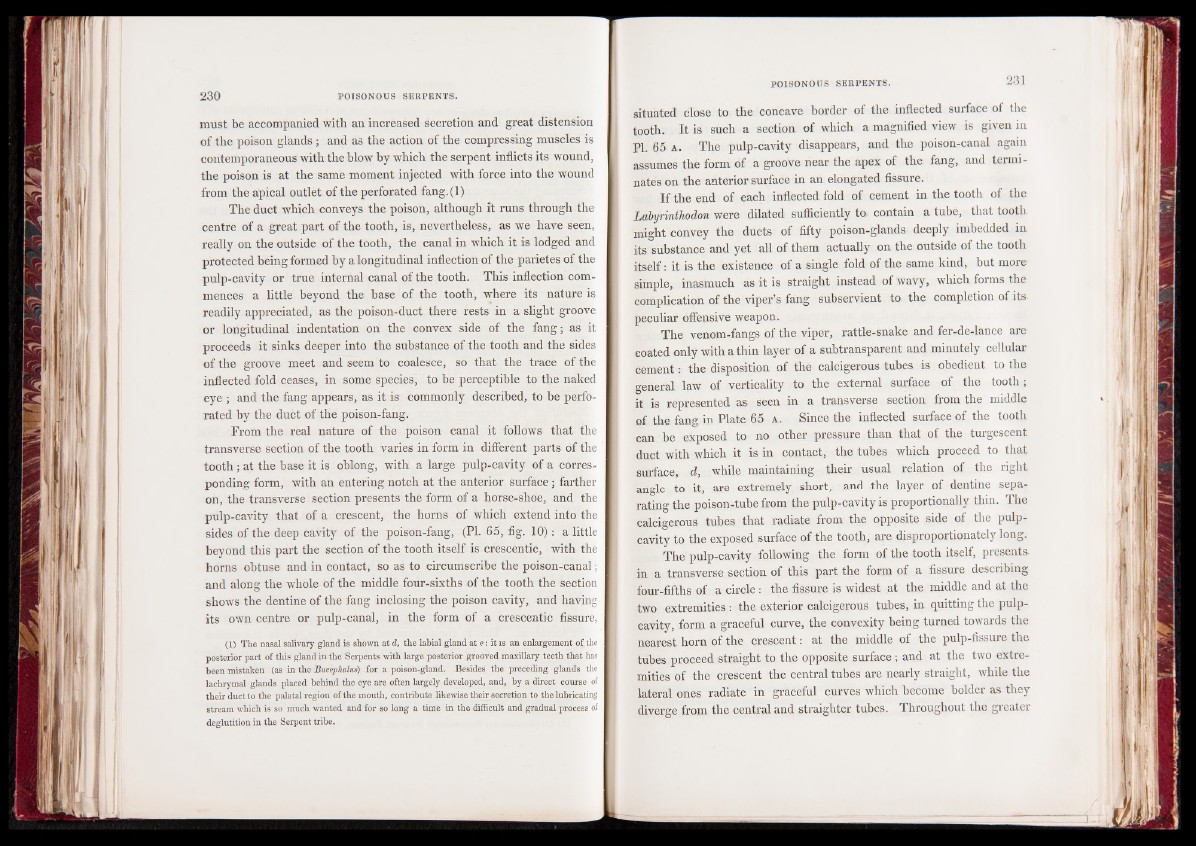
must be accompanied with an increased secretion and great distension
of the poison glands ; and as the action of the compressing muscles is
contemporaneous with the blow by which the serpent inflicts its wound,
the poison is at the same moment injected with force into the wound
from the apical outlet of the perforated fang.(l)
The duct which conveys the poison, although it runs through the
centre of a great part of the tooth, is, nevertheless, as we have seen,
really on the outside of the tooth, the canal in which it is lodged and
protected being formed by a longitudinal inflection of the parietes of the
pulp-cavity or true internal canal of the tooth. This inflection commences
a little beyond the base of the tooth, where its nature is
readily appreciated, as the poison-duct there rests in a slight groove
or longitudinal indentation on the convex side of the fang; as it
proceeds it sinks deeper into the substance of the tooth and the sides
of the groove meet and seem to coalesce, so that the trace of the
inflected fold ceases, in some species, to he perceptible to the naked
eye ; and the fang appears, as it is commonly described, to he perforated
by the duct of the poison-fang.
From the real nature of the poison canal it follows that the
transverse section of the tooth varies in form in different parts of the
tooth; at the base it is oblong, with a large pulp-cavity of a corresponding
form, with an entering notch at the anterior surface; farther
on, the transverse section presents the form of a horse-shoe, and the
pulp-cavity that of a crescent, the horns of which extend into the
sides of the deep cavity of the poison-fang, (PI. 65, fig. 10) : a little
beyond this part the section of the tooth itself is crescentic, with the
horns obtuse and in contact, so as to circumscribe the poison-canal;
and along the whole of the middle four-sixths of the tooth the section
shows the dentine of the fang inclosing the poison cavity, and having
its own centre or pulp-canal, in the form of a crescentic fissure,
(1) The nasal salivary gland is shown at d, the labial gland at e: it is an enlargement of. the
posterior part of this gland in the Serpents with large posterior grooved maxillary teeth that has
been mistaken (as in the Bucephalus) for a poison-gland. Besides the preceding glands the
lachrymal glands placed behind the eye are often largely developed, and, by a direct course of
their duct to the palatal region of the mouth, contribute likewise them secretion to the lubricating
stream which is so much wanted and for so long a time in the difficult and gradual process of
deglutition in the Serpent tribe.
situated close to the concave border of the inflected surface of the
tooth. It is such a section of which a magnified view is given in
PI. 65 a . The pulp-cavity disappears, and the poison-canal again
assumes the form of a groove near the apex of the fang, and terminates
on the anterior surface in an elongated fissure.
If the end of each inflected fold of cement in the tooth of the
Labyrinthodon were dilated sufficiently to contain a tube, that tooth
might convey the ducts of fifty poison-glands deeply imbedded in
its substance and yet all of them actually on the outside of the tooth
itself: it is the existence of a single fold of the same kind, hut more
simple, inasmuch as it is straight instead of wavy, which forms the
complication of the viper’s fang subservient to the completion of its
peculiar offensive weapon.
The venom-fangs of the viper, rattle-snake and fer-de-lance are
coated only with a thin layer of a subtransparent and minutely cellular
cement: the disposition of the calcigerous tubes is obedient to the
general law of verticality to the external surface of the tooth;
it is represented as seen in a transverse section from the middle
of the fang in Plate 65 a . Since the inflected surface of the tooth
can be exposed to no other pressure than that of the turgescent
duct with which it is in contact, the tubes which proceed to that
surface, d, while maintaining their usual relation of the right
angle to it, are extremely short, and the layer of dentine separating
the poison-tube from the pulp-cavity is proportionally thin. The
calcigerous tubes that radiate from the opposite side of the pulp-
cavity to the exposed surface of the tooth, are disproportionately long.
The pulp-cavity following the form of the tooth itself, presents
in a transverse section of this part the form of a fissure describing
four-fifths of a circle: the fissure is widest at the middle and at the
two extremities : the exterior calcigerous tubes, in quitting the pulp-
cavity, form a graceful curve, the convexity being turned towards the
nearest horn of the crescent: at the middle of the pulp-fissure the
tubes proceed straight to the opposite surface ; and at the two extremities
of the crescent the central tubes are nearly straight, while the
lateral ones radiate in graceful curves which become bolder as they
diverge from the central and straighter tubes. Throughout the greater